茶院 – 草廠北巷24號改造 / 兼建筑
四合院更新的微介入
設計公司:兼建筑
位置:中國
類型:建筑
材料:木材 磚石 玻璃
標簽:Beijing 北京
分類:辦公室 商業(yè)建筑
四合院更新的微介入——是草廠北巷24號改造關于城市更新的一次設計實踐: 以連接城市文脈,結(jié)合新的使用群體和功能,探索用較小動作,較低成本的建造,實現(xiàn)四合院微更新的一次嘗試。
The micro-intervention of courtyard houses renewal, the reconstruction of No. 24 Caochang North Lane, is a design practice of the urban renewal, exploring the possibility of micro-intervention of courtyard houses with minimal changes and low-cost construction to connect the urban context and integrate the new use groups and programs.
▼改造后的庭院,The courtyard after renovation ©金偉琦
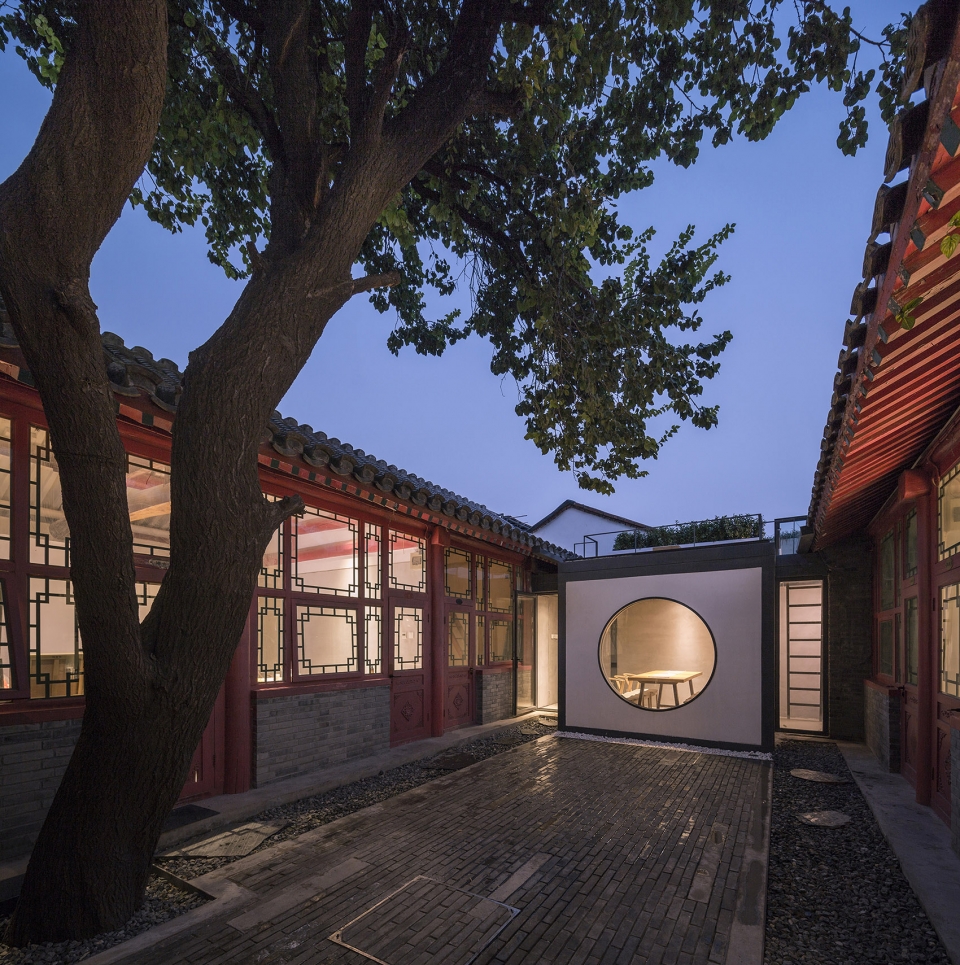
城市文脈
Urban Context
本項目位于草場北巷,毗鄰鐘鼓樓——作為該區(qū)域的標志性建筑,其傳統(tǒng)古建筑的氣場影響著場地周邊的氛圍。上百年來鐘鼓樓用晨鐘暮鼓為城市報時,如今鐘鼓雖不再響起,卻留下了場地關于“時間”的場所記憶。鐘鼓樓廣場幾乎是到達本次項目基地的必經(jīng)之地,一路走來,市井嘈雜的胡同在這樣的場域氛圍下,也變得寧靜而有了秩序感。
The project is located at Caochang North Lane, adjacent to the Bell and Drum Tower. As the symbolic building of the area, the traditional Chinese architecture has large impact on its surroundings. With its morning bell and evening drum, the tower has been announcing the time for hundreds of years. Even though the bell and drum are no longer ringing, it has left the site with the memory of “time”. The Bell and Drum tower plaza is on the way to the project. Along the walk, the bustling lanes are becoming quiet and organized in such a neighborhood.
▼總圖,Site plan
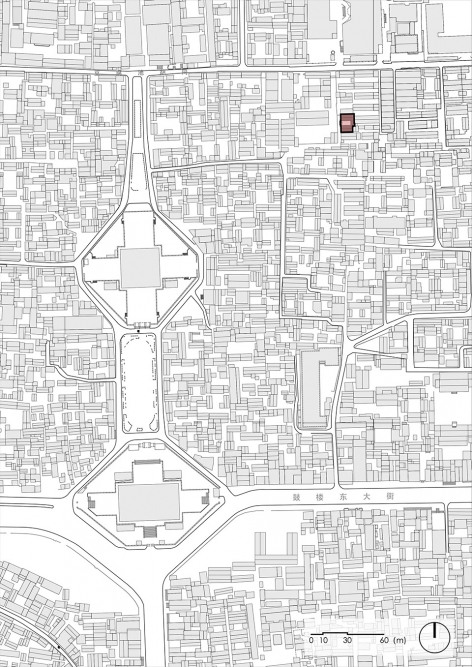
▼場地與鐘鼓樓空間關系圖,Spatial Diagram of the site and the Bell and Drum Tower
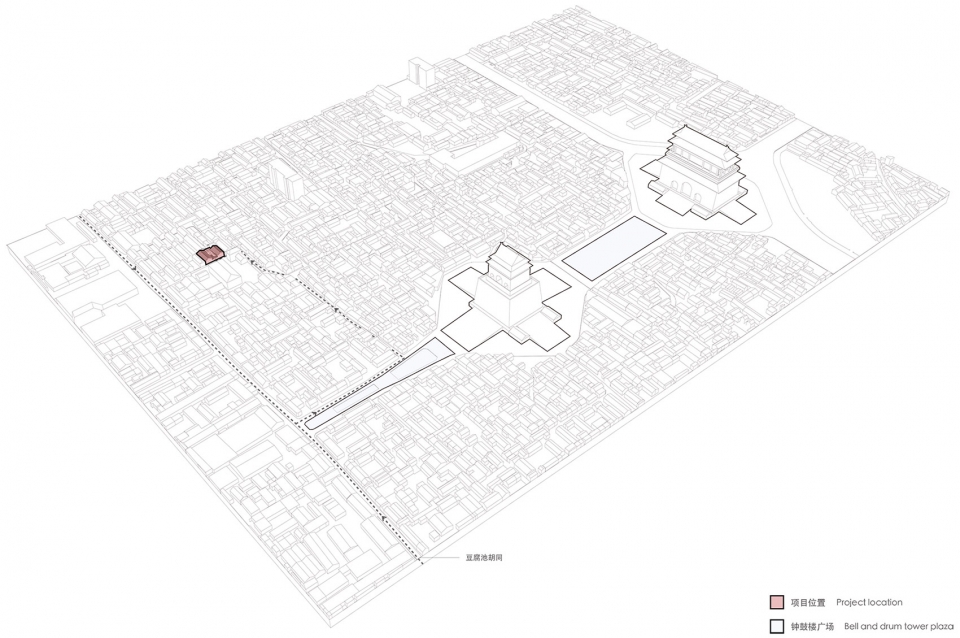
使用群體與功能
Use Group and Functions
在目前北京二環(huán)內(nèi)的城市發(fā)展中,人口結(jié)構(gòu)的的變化是推動古城更新的重要因素,新的使用群體為古城注入新的活力。本次項目的委托方犀牛會是一家閩籍互聯(lián)網(wǎng)企業(yè)。飲茶是福建人生活中必不可少的部分。生活方式?jīng)Q定了茶室在這個空間中的重要性。不一樣的生活方式,塑造不同的空間形態(tài)。在這里興造一座茶室是源自生活本身的詩意。
In the current urban development within the second ring road of Beijing, the change of the use group is an important factor to promote the renewal of the ancient city. Along with the people, various cultural tradition and lifestyle inject new energy into the ancient city. Xiniuhui, the client of the project, is a Fujian internet enterprise. Tea drinking is an indispensable ritual for Fujian people. As different lifestyles form different spaces, the lifestyle of Fujian people determines the role of tea house in the space. Building a tea house here originates from the poetic of life itself.
▼小院門口,The entrance of the courtyard ©陳培新
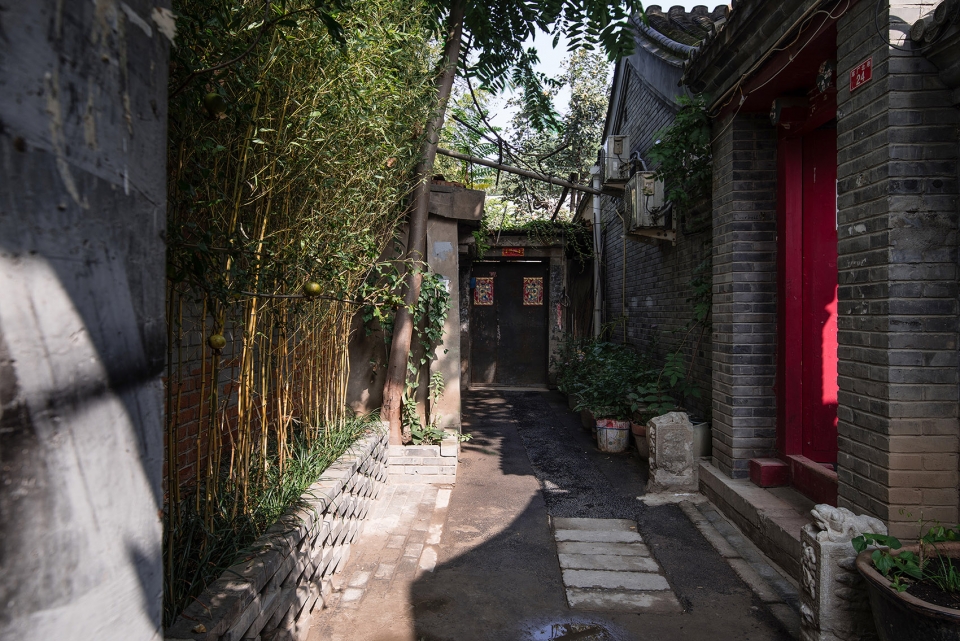
▼鳥瞰圖,Aerial view ©陳培新
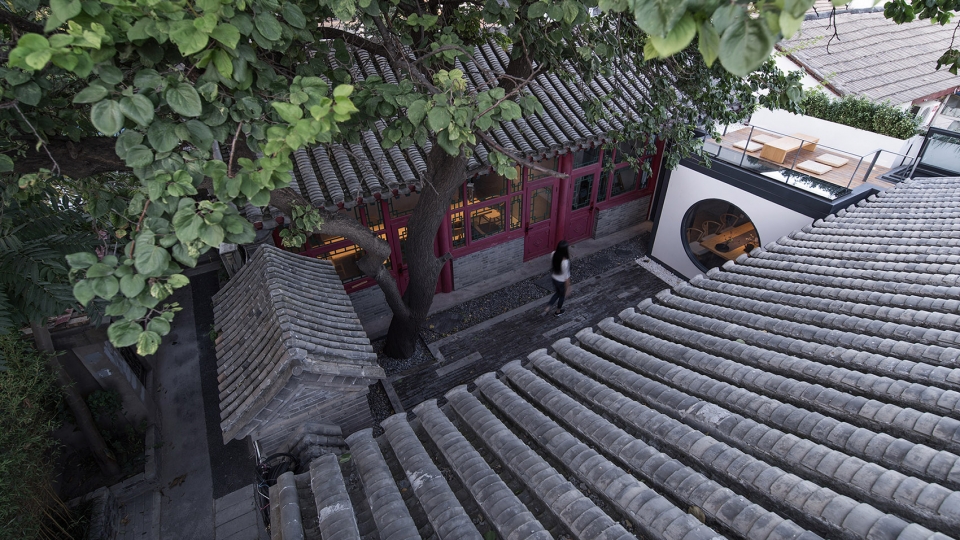
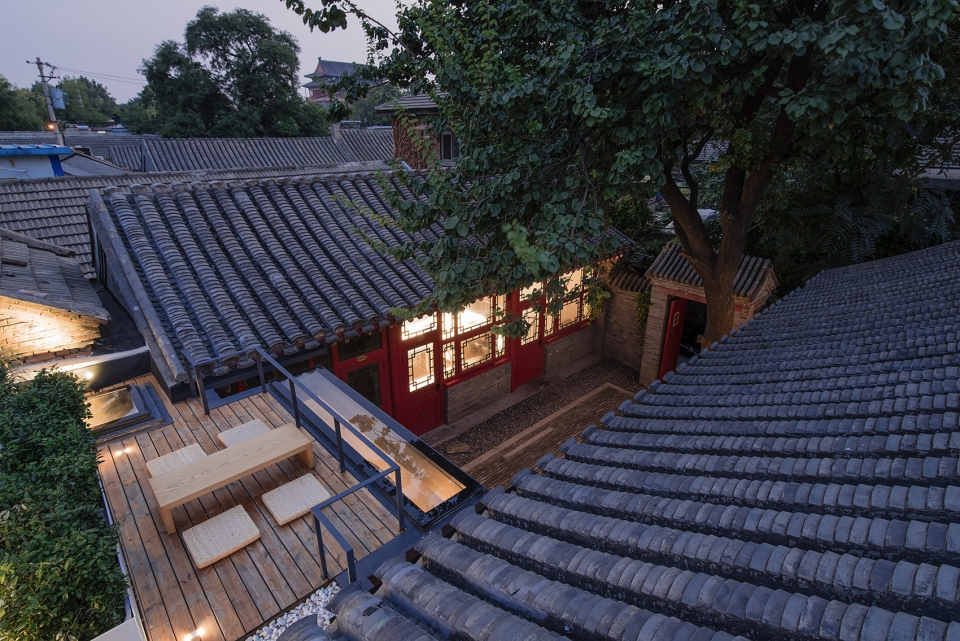
微介入
The micro-intervention
改造前,這里是一家即將被棄用的胡同民宿,擁有7間客房,每個房間風格各異,庭院略顯嘈雜,與委托方的需求格格不入。使用功能與需求不相符,而改造預算卻十分有限。在這樣的情況下建筑師提出通過局部改造(微介入)的策略,在四合院中加入核心功能——茶室,借此改變四合院的整體氛圍。
Before the renovation, it was a Hutong homestay about to be abandoned, with 7 rooms of different styles and a slightly busy courtyard, which was incompatible with the client’s needs. The space didn’t match the program while the budget for renovation was quite limited. In this situation, the architect proposed a strategy of partial renovation (micro-intervention) by adding a core function—a tea room into the courtyard, so as to change the spatial quality of the courtyard house.
▼從露臺看向庭院,The courtyard view from the terrace ©陳培新

▼改造前的庭院,view of the courtyard before renovation

改造中,只拆除較為破敗狹小的東屋、南北房的兩道隔斷墻及衛(wèi)生間。置入三個方盒子,一個加于院中,作為茶室;另兩個融入南北兩房,作為開放辦公室與多功能室。其余三個房間,廚房及兩個客房基本保留原有格局:一個客房改為小茶室兼會客室,另一個客房作為員工休息室而整體保留。新加部分嵌入到原有四合院中,新舊保有各自的性格。
During the process of renovation, only small portion of the house were demolished: the dilapidated narrow east room, the two partition walls of the south and north room and the toilet. Three boxes were added. One was added in the courtyard as a tea room and the other two were integrated into the north and south rooms as an open office and a multi-function room. The rest three rooms, one kitchen and two guest rooms were basically kept in the original layout with one guest room converted into a small tea room and meeting room and the other retained as a staff lounge. As the new part was embedded into the original courtyard, both the original and new parts maintained their own characteristics.
▼設計生成,Design generation (動圖GIF)
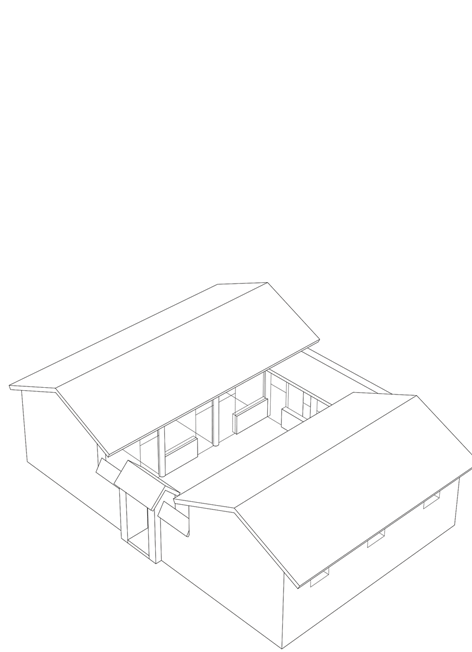
▼庭院一側(cè)的多功能室,view of the multi-function room from the courtyard ©陳培新
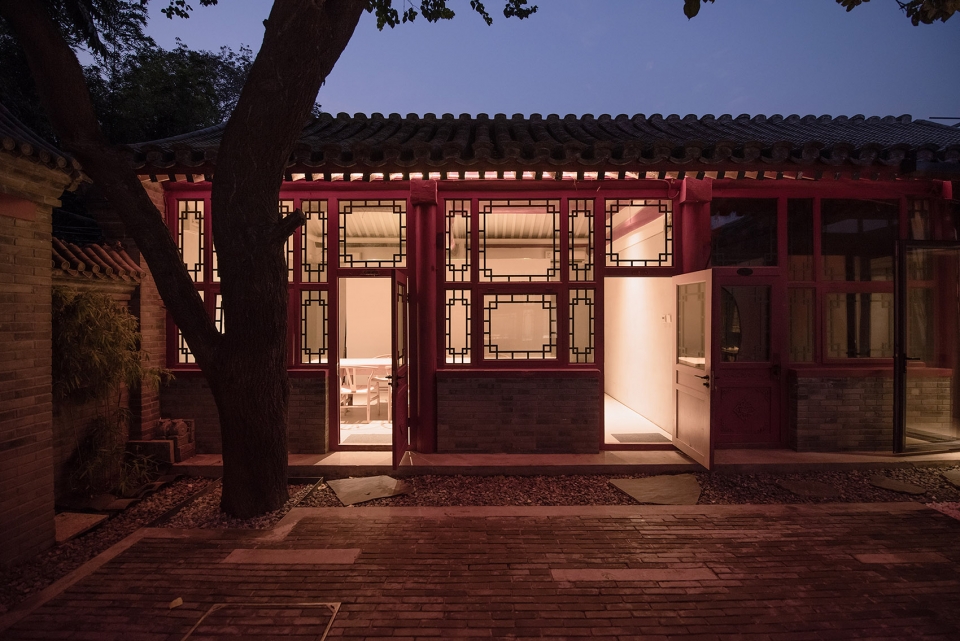
茶室生成
The Generation of the Tea house
茶室設計的思路源于對場地中“時間”的思考。建筑師有意在這里連接杏樹、茶室與太陽,探討“時間”在這個場地中所帶來的變化。樹與茶室相距6米,樹冠半徑正好在5-6米之間,樹高13米。太陽一天的移動使院中的樹影隨之而變:午后樹影開始進入茶室圓窗,并在茶桌上產(chǎn)生粼粼波光,暗調(diào)的茶室也由于光線的進入而產(chǎn)生特別的儀式感,在光影游走中,于3-4點之間達到高潮。
The idea of the tea house comes from the contemplation on “time” on the site. The architect intends to connect the apricot tree, the tea house, and the sun to explore the changes brought by “time” to this site. The distance between the tree and the tea house is 6 meters. The crown radius of the tree is 5 to 6 meters and the tree is 13-meter high. The movement of the sun throughout a day projects the shadows of tree in the courtyard, which comes through the round window of the tea house in the afternoon, reflecting sparkling lights on the table. A sense of serenity is emerges in the room as the light enters, which reaches a climax in the lights and shadows around 3 to 4 in the afternoon.
▼茶室與樹一天的光影關系分析圖
The shadow diagram between the tea house and the tree in a day
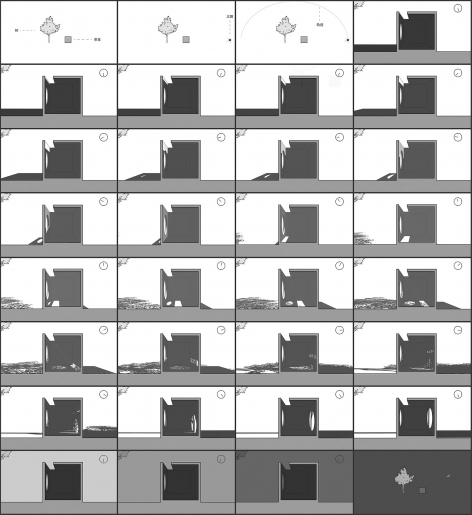
▼午后的茶室,The tea house in the afternoon ©陳培新

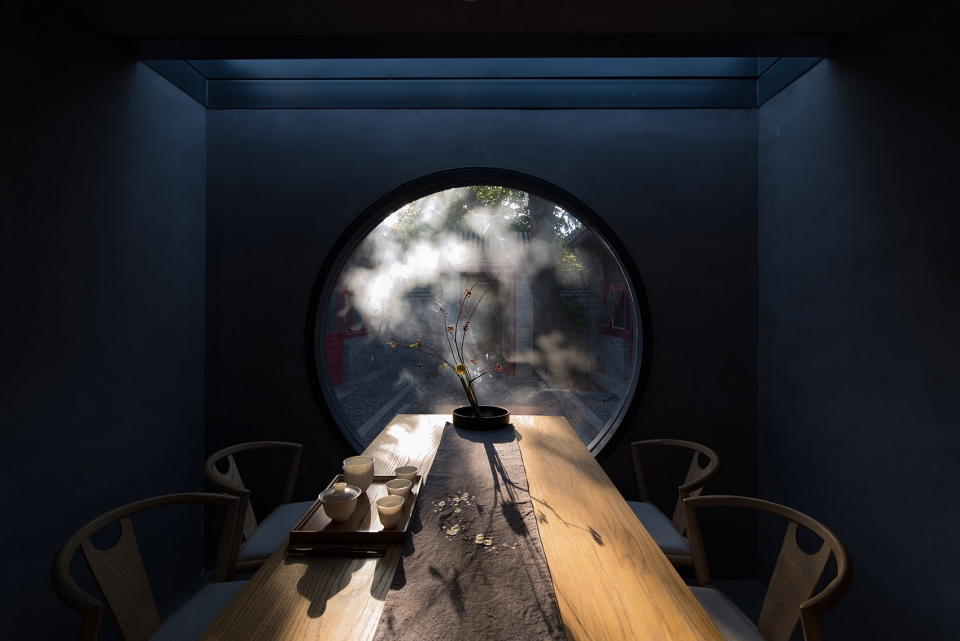
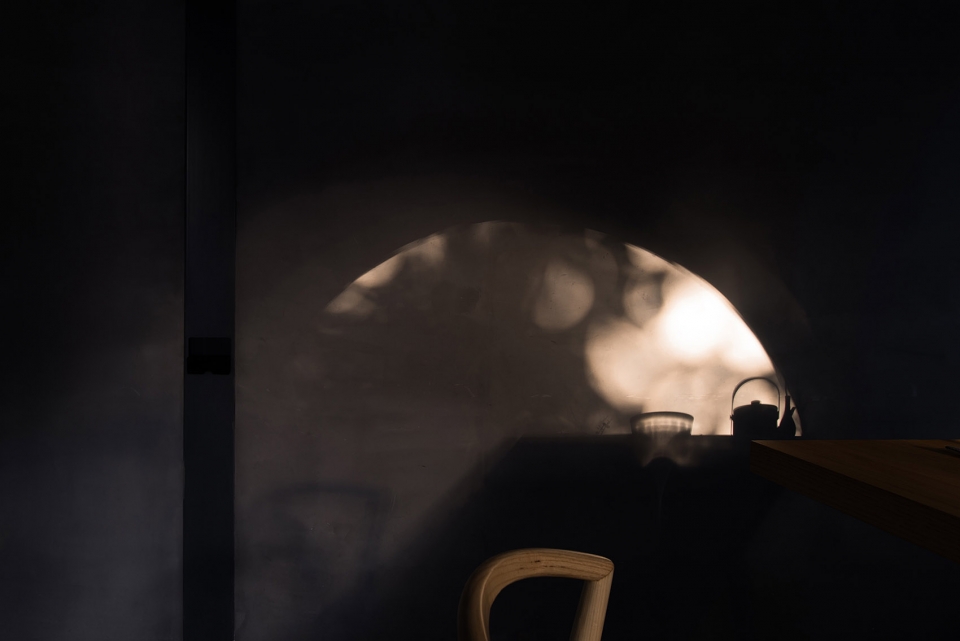
▼院子內(nèi)一天光影變化 , The changes of light and shadow in the courtyard throughout a day ©陳培新
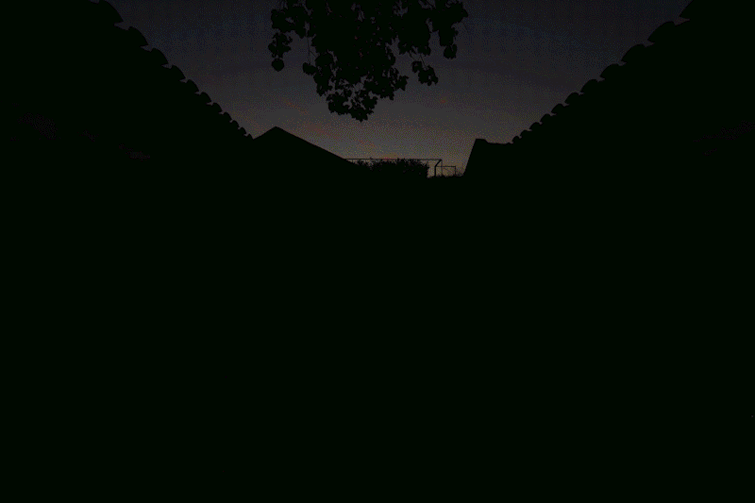
▼茶室內(nèi)下午光影變化,The changes of light and shadow in the tea house in the afternoon ©陳培新
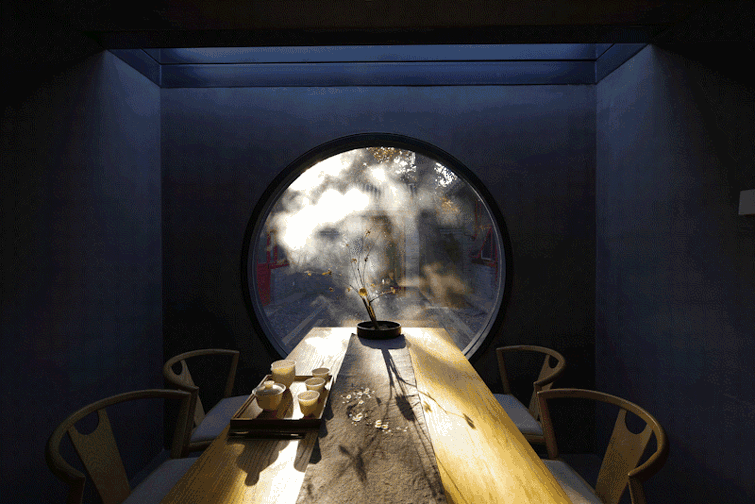
圓形窗的設置,是對茶室空間虛與實的思考,即充當一個光線的收納器,也是對視線的引導,在透與不透之間,增加院子的空間層次。由外而內(nèi),茶室是院中對景;由內(nèi)而外,茶室是溝通人與自然的媒介。
The circular window is out of the consideration of the void and solid space of the tea house, which acts as a receiver of light, and guides the sight at the same time so that it increases the spatial level of the yard. While looking from the outside to the inside, the tea house is the opposite scenery of the courtyard; from the inside to the outside, the tea house is the medium of communication between man and nature.
▼樹影投上開有圓窗的白墻,The tree shadows on the wall with round window ©陳培新
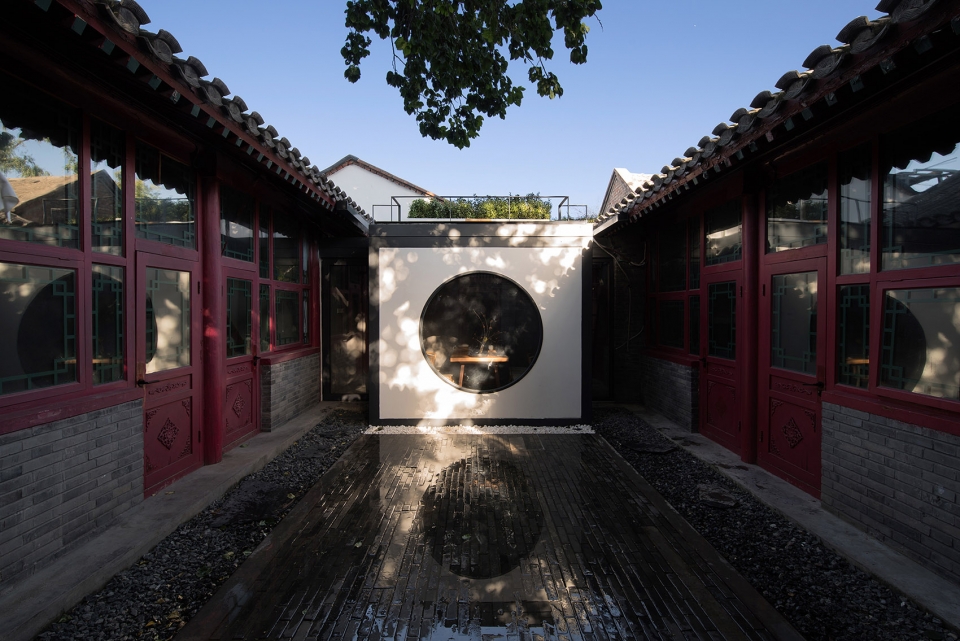
▼茶室內(nèi)部看向院子,Looking at the courtyard from the tea house ©陳培新
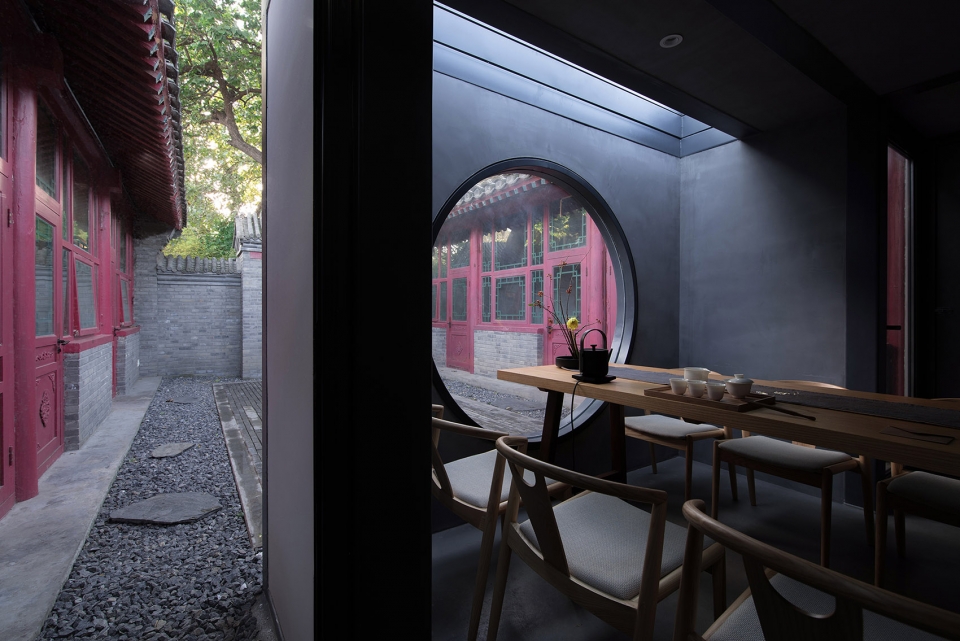
▼在茶室中悠然沏茶,Make tea in the tea house ©陳培新
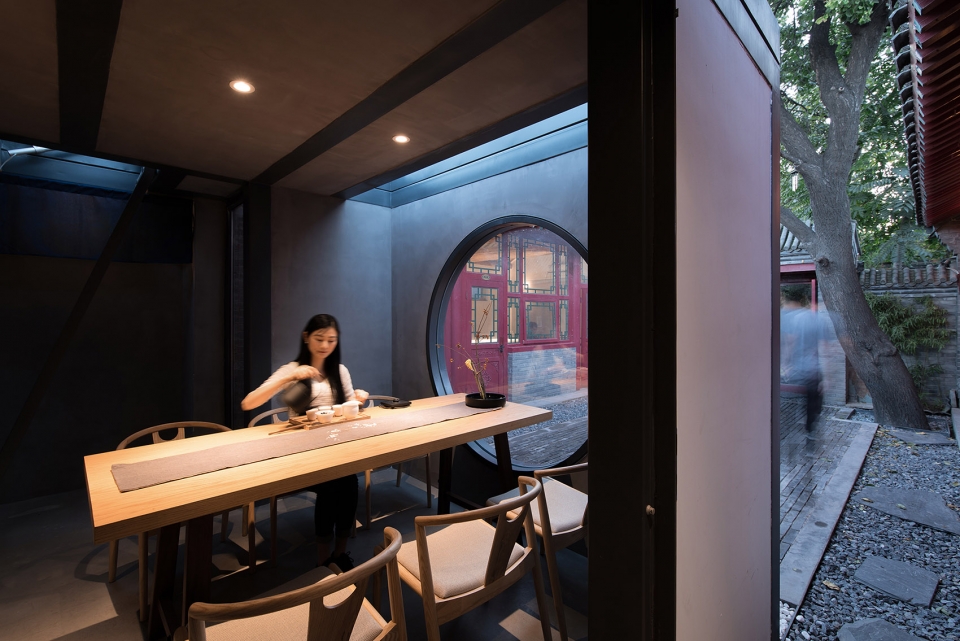
▼長方形天窗與圓窗,Rectangular skylight and round window ©陳培新
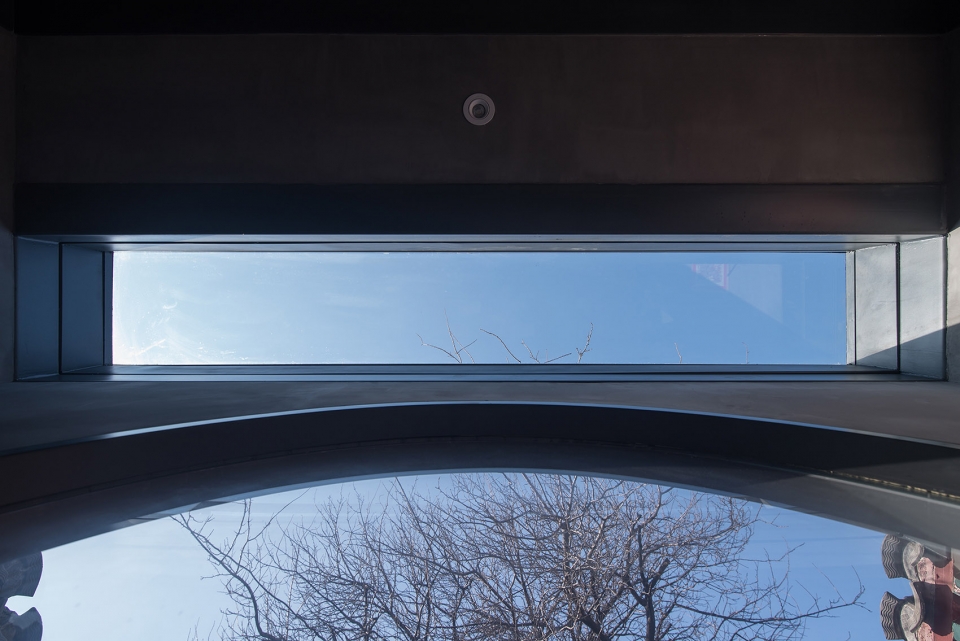
▼透過天窗看杏樹,Apricot trees seen through skylights ©陳培新
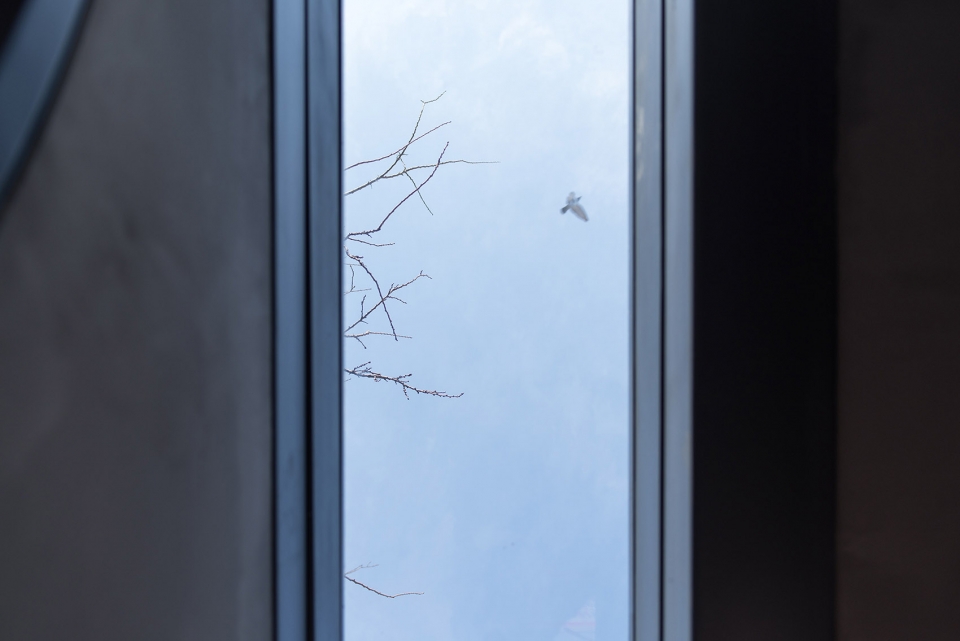
▼茶室爆炸軸測圖,Tea house explosion axonometric mapping
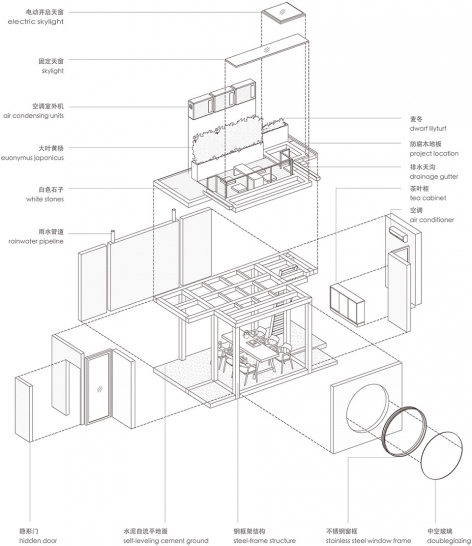
興造與材質(zhì)
Construction and Materials
新建茶室使用了鋼結(jié)構(gòu),結(jié)構(gòu)構(gòu)件外露,強調(diào)空間中的線條關系,與原建筑的木結(jié)構(gòu)相呼應。露臺欄桿被縮小了高度,讓飲茶者入座后,隱匿于山墻之下,融于環(huán)境之中。雙層茶空間不僅加深了與杏樹的對話,創(chuàng)造了不同的喝茶體驗,還可在露臺上遠眺鐘鼓樓,在空間上又一次與城市產(chǎn)生連接。
The steel structure is used for the new tea house. With the structural members exposed, it emphasizes the relationship of the lines in the space and echoes the wooden structure of the original building. The terrace railing is reduced in height to allow the tea drinkers to get themselves hidden inside the gables and involved in the environment. The double-layer space of the tea house not only deepens the communication between man and the apricot tree so as to create different experience about tea drinking, but also connects with the city once again by overlooking the Bell and Drum tower from the terrace.
▼天窗,The skylight ©陳培新
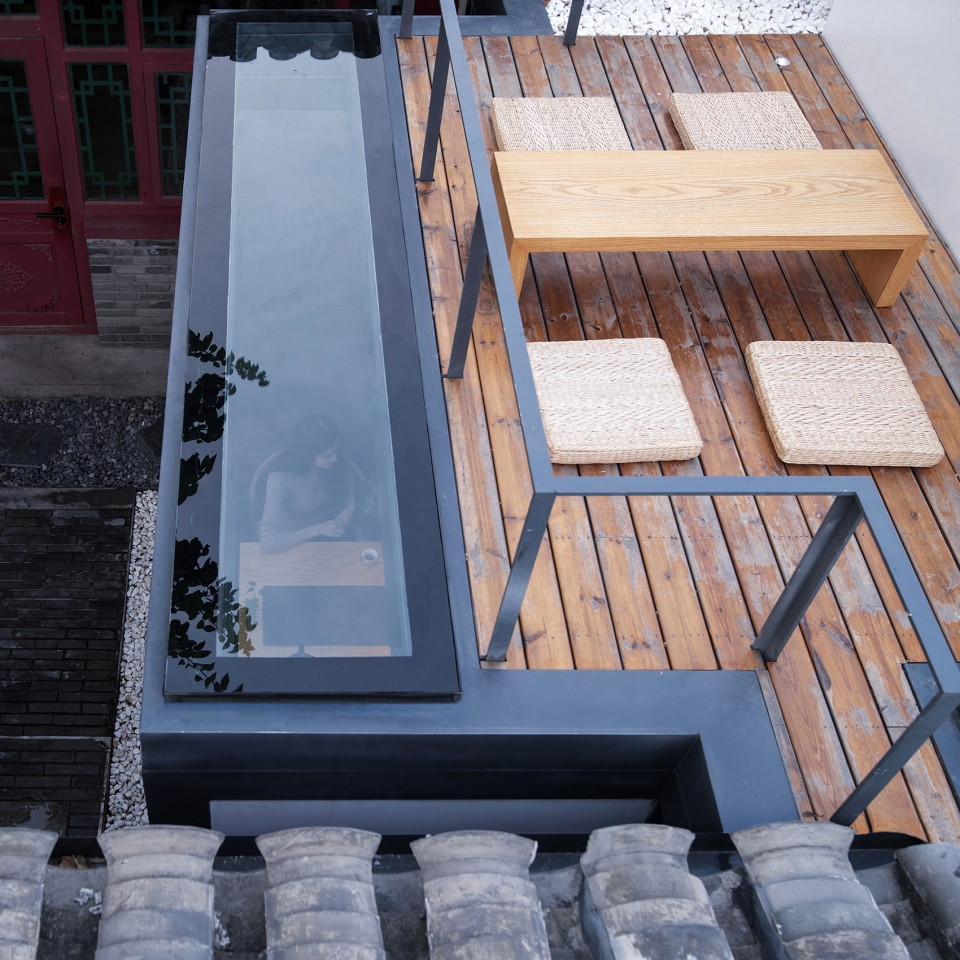
▼露臺,The terrace ©陳培新
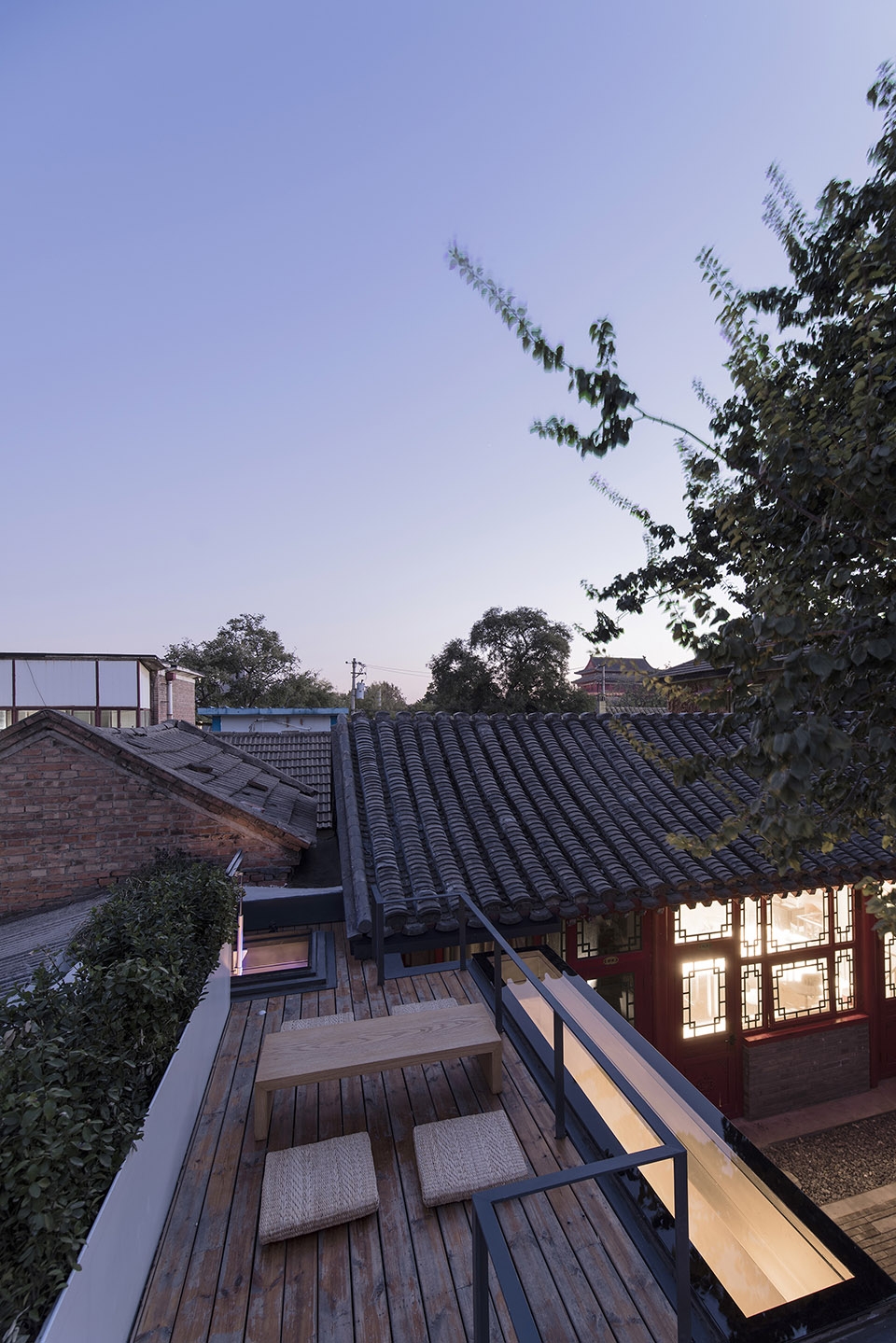
▼遠眺鐘鼓樓,Overlooking the bell and drum tower ©陳培新
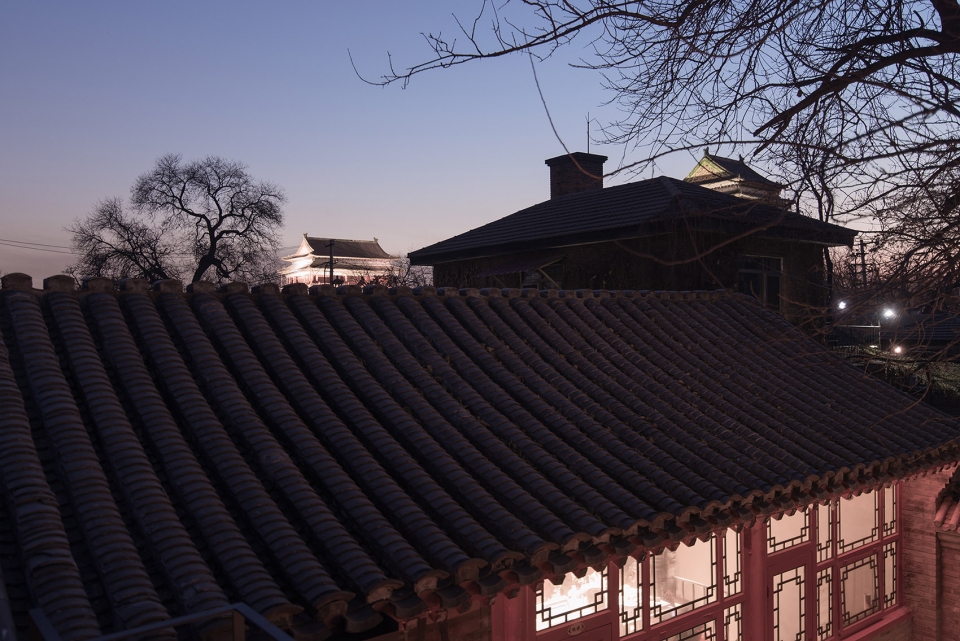
庭院青磚立砌,沿東西向排布,內(nèi)部錯落嵌入條形混凝土,線性的節(jié)奏讓狹小的庭院稍顯舒展。青磚與青石延續(xù)了新加的灰色調(diào)元素,只留出茶室正面的白墻,以接收杏樹的光影。南北房內(nèi)部屋頂保留了原有的材質(zhì),新舊之間通過槽鋁分割開來,一條延續(xù)的線條分出上下、新舊的質(zhì)感。
The courtyard is built of black bricks and arranged along the east-west direction. With the strips of concrete embedded between the black bricks, the horizontal pattern widens the width of the narrow courtyard. The black bricks and black stones correspond with the overall gray tone, leaving the white front wall of the tea house alone to receive the light and shadow of the apricot tree. As the interior roof of the north and south houses retains the original material, the new and the old are separated by the aluminum groove, making a continuous line to separate the texture between the upper and lower as well as the new and the old.
▼新舊之間,Between the old and new ©陳培新
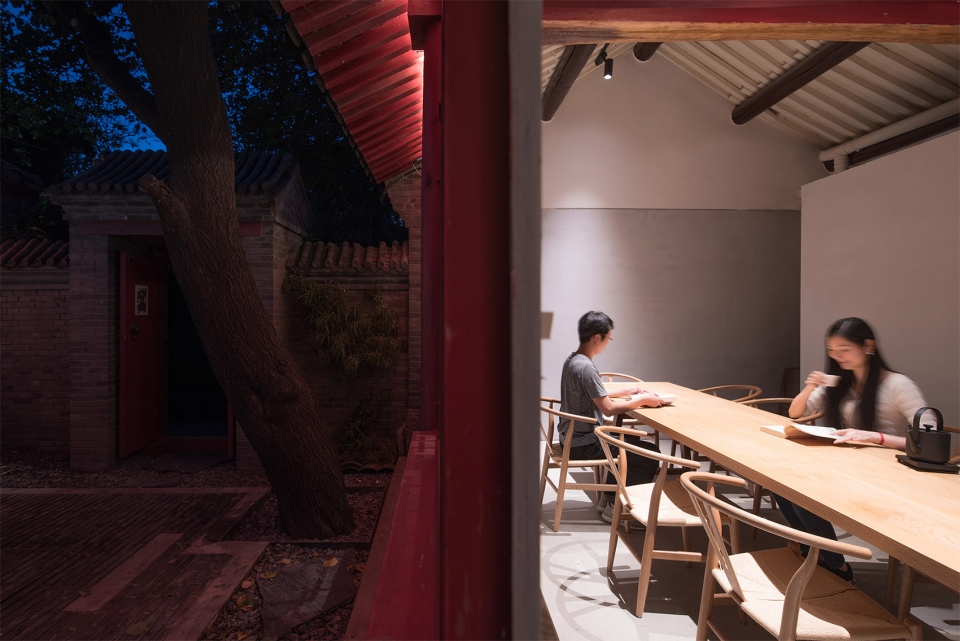
小院新生
Rebirth of the Courtyard
整個項目中,建筑師參與到建筑前期策劃,通過微介入的方式使四合院空間適應新的使用需求。新與舊的對話是對建筑現(xiàn)狀的尊重,以此延續(xù)城市的良性更新;新加茶室在四合院中探討人與自然的關系,這是對傳統(tǒng)精神的回應,也是對當下生活的反思。
In the whole project, the architect participated in the early planning of the renovation, and made the space of the courtyard adapt to the new needs by the means of micro-intervention. The dialogue between the new and the old is the respect for architecture as it is thus to continue the benign metabolism of the city; the new tea house explores the relationship between man and nature in the courtyard, which is a response to the traditional values as well as a reflection on the present life.
▼茶室夜景,The tea house at night ©金偉琦
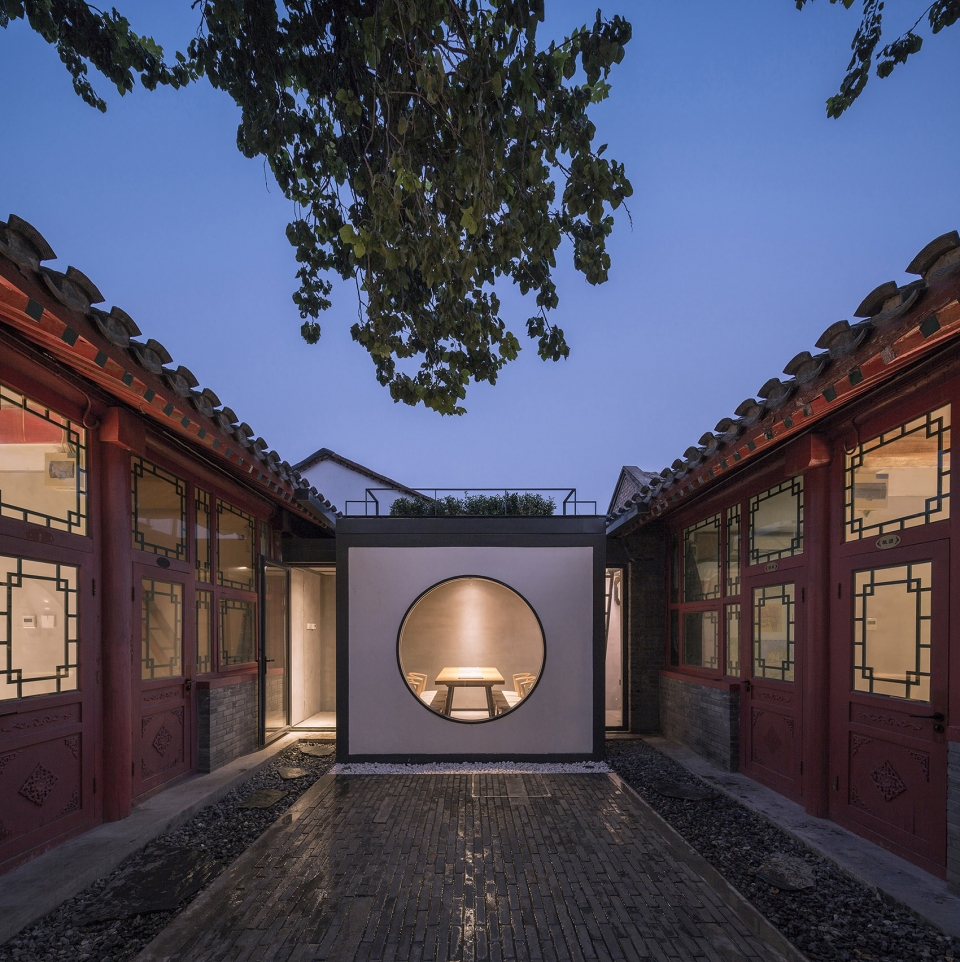
▼一層平面圖,Ground floor plan
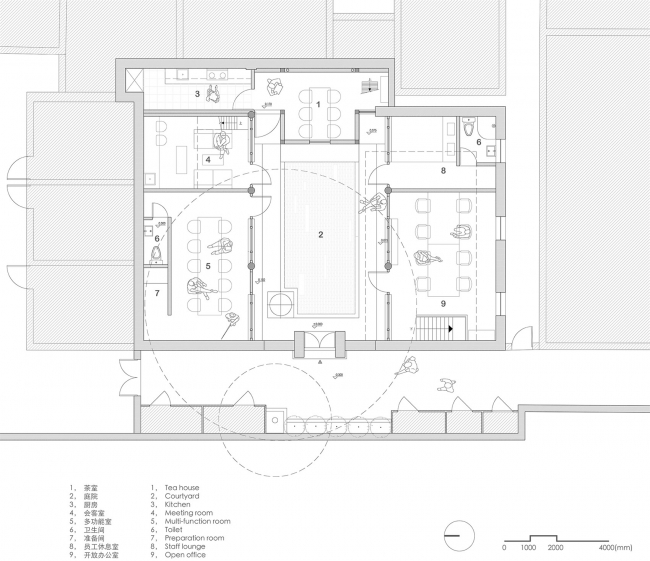
▼屋頂平面圖,Roof plan
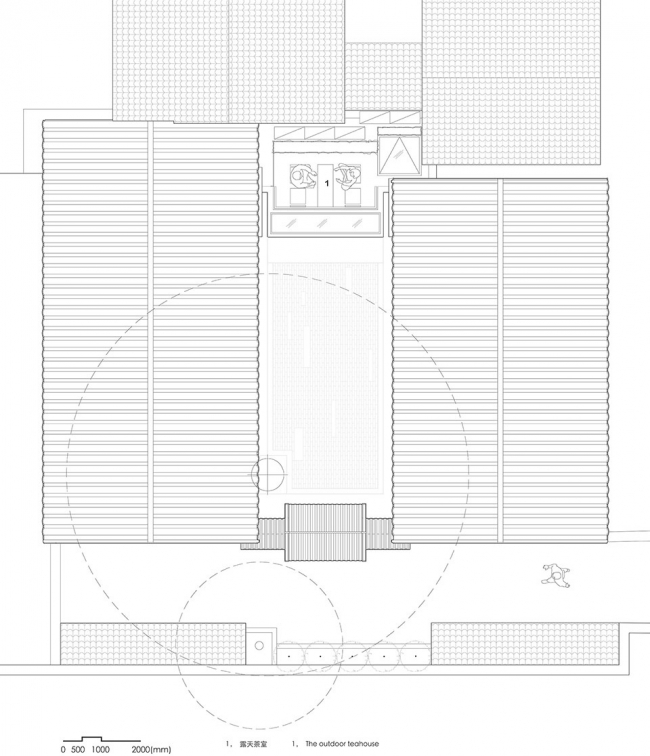
▼剖透視圖 , Section view
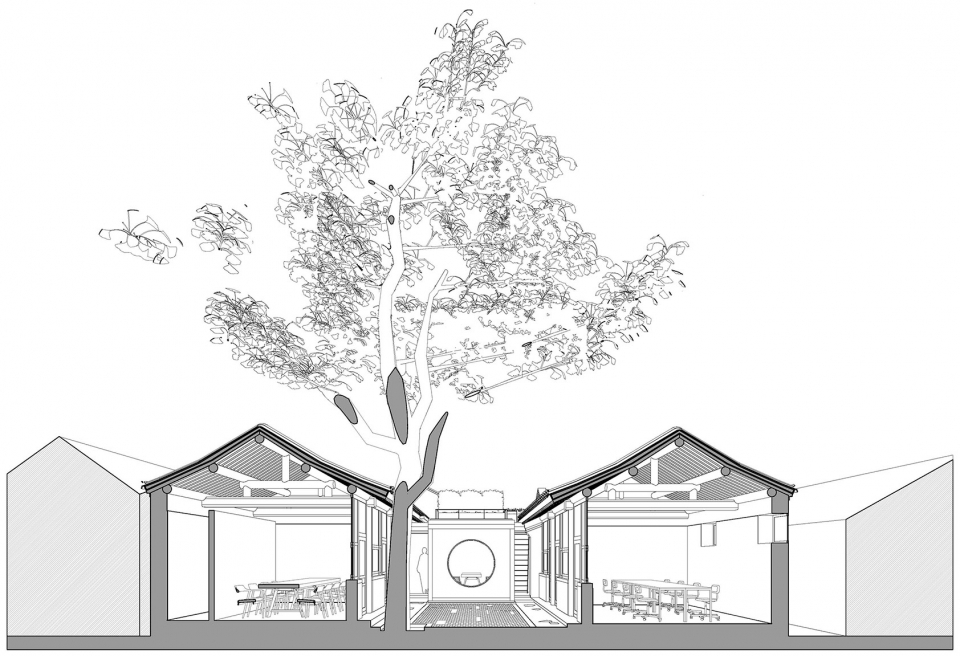
項目名稱:茶院·草廠北巷24號改造
設計:兼建筑
聯(lián)系郵箱: atelier-jian@outlook.com
項目設計:2017
項目完成:2018
主創(chuàng)設計師:陳培新
項目地址:中國,北京
建筑面積:140.0㎡
攝影:金偉琦,陳培新
客戶:犀牛會
Project name: Tea Garden· Renovation of No.24 Caochang North Lane
Designed: Atelier Jian
Contact e-mail: atelier-jian@outlook.com
Design year: 2017
Completion Year:2018
Leader designer: Chen Peixin
Project location: Beijing, China
Gross Built Area : 140.0㎡
Photo credits: Jin Weiqi, Chen Peixin
Client: Xiniuhui
來源:本文轉(zhuǎn)載自谷德設計網(wǎng)(gooood)
我們重在分享,尊重原創(chuàng)。如涉及作品內(nèi)容、版權(quán)和其它問題,請與本網(wǎng)聯(lián)系,我們將在第一時間刪除內(nèi)容!
- 時間 2019-02-19 /
- 作者 gooood /


